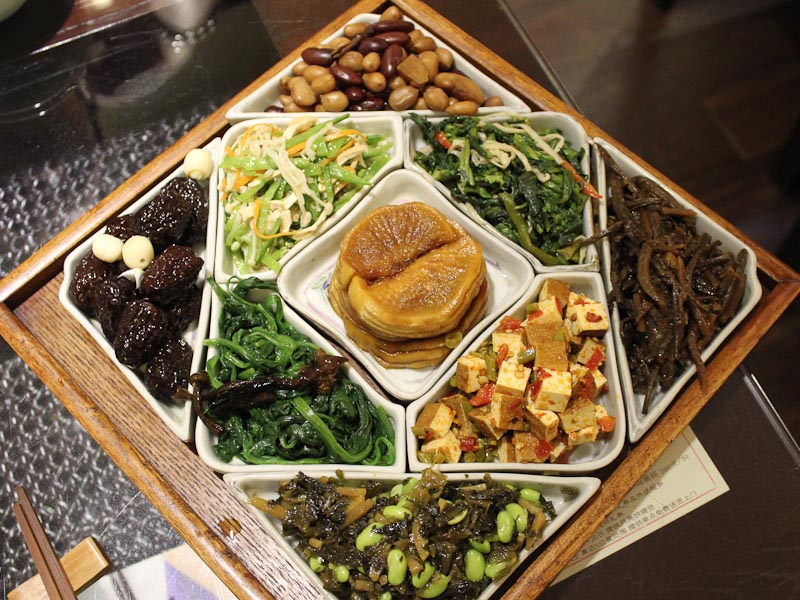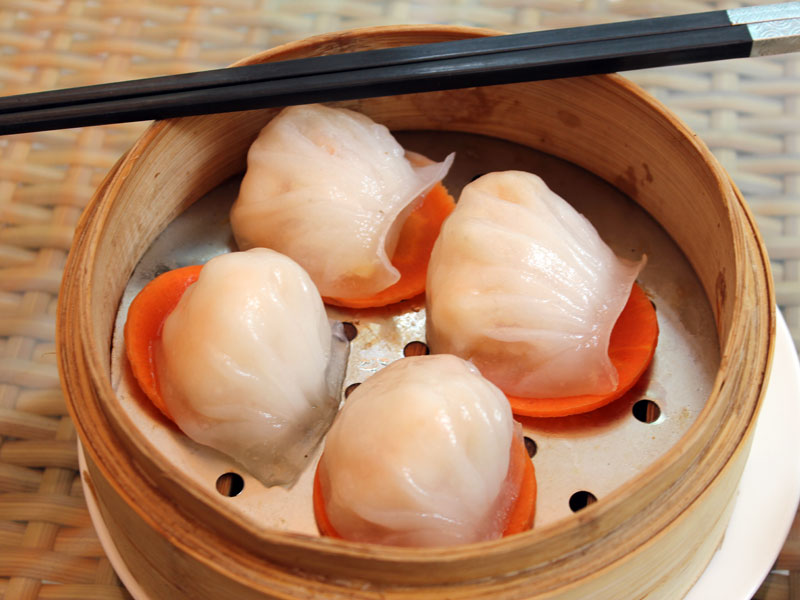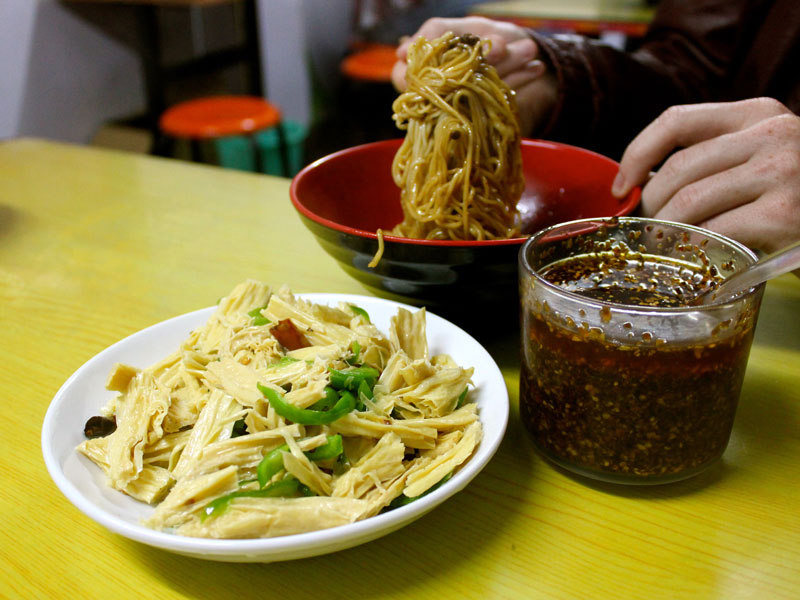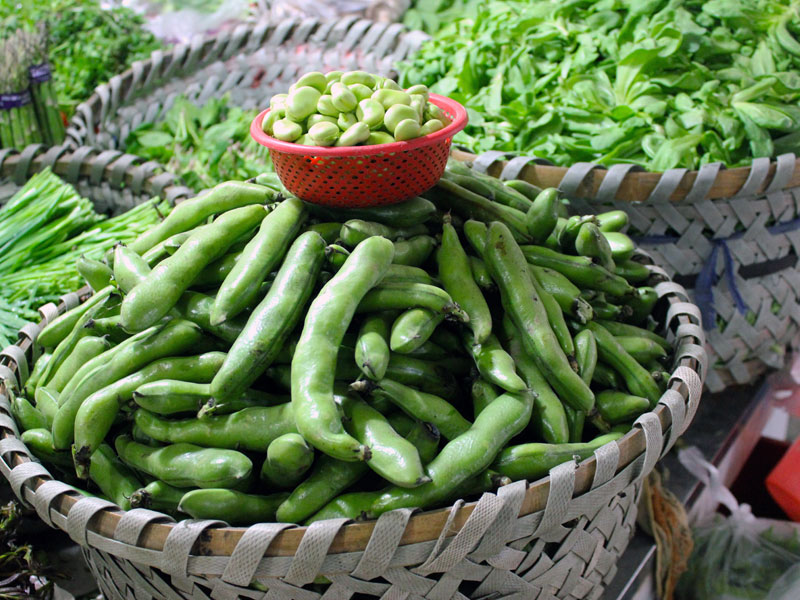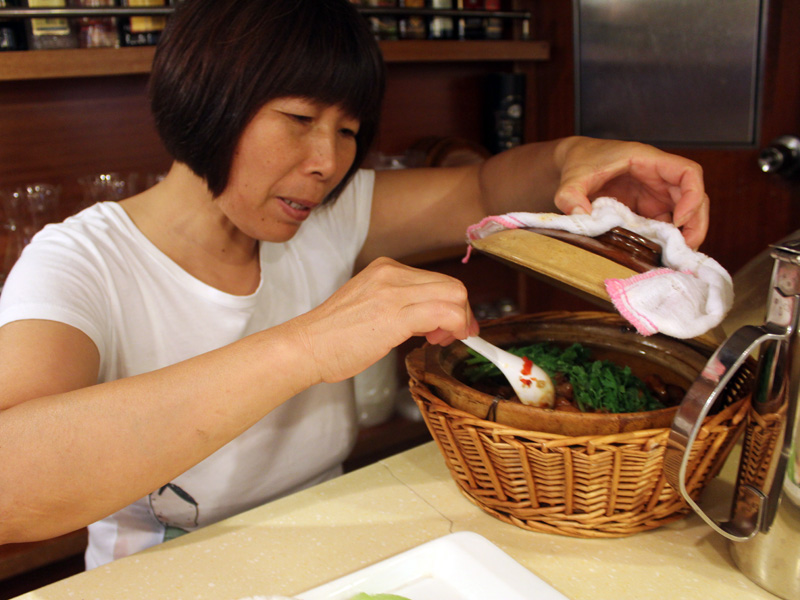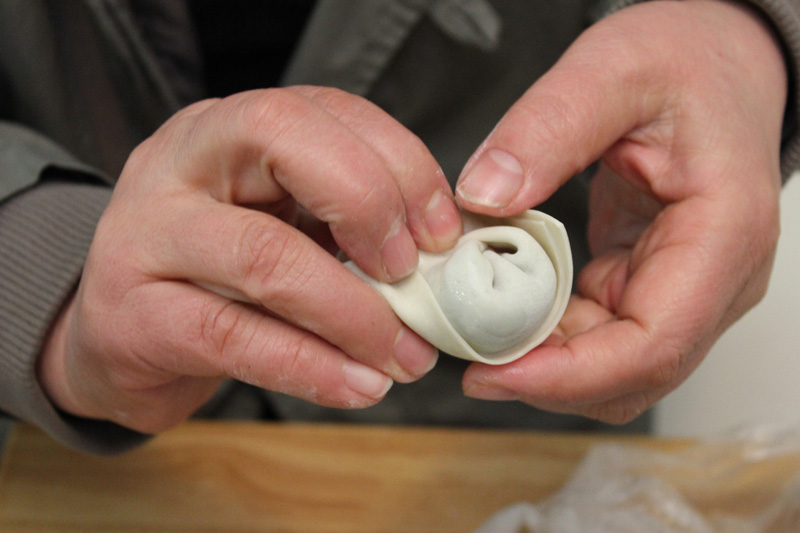We can't find the internet
Attempting to reconnect
Something went wrong!
Hang in there while we get back on track
Search results for "Jamie Barys"
Shanghai
Wu Guan Tang: The Monastic Cafeteria
Dining at Buddhist temples in China can be a disappointing experience. Too often, these halls of worship have been turned into tourist traps that solicit enough donations to keep the monks in expensive trainers, meat-based meals and high-end smart phones. Independent Buddhist restaurants, like Wu Guan Tang (五观堂), are a breath of fresh air, maintaining the tenets of the religion while offering quality vegetarian food in a peaceful environment.
Read moreShanghai
Xin Dau Ji: The Great Outdoors
Nothing beats an alfresco summer meal in Shanghai, yet it’s not easy to find a Chinese restaurant that offers outdoor seating. While Chinese people prefer to shelter under umbrellas during the hottest months, Shanghai’s sun-worshipping expats flock to patios and terraces – most of them located in Western-style establishments. So the opening last summer of Cantonese restaurant Xin Dau Ji, with its expansive deck outside, complete with fans for open-air breezes, was a very pleasant surprise. The venue’s outdoor tables sprawl into the former French Concession’s Xiangyang Park, one of Shanghai’s smallest parks, built in the 1930s for French children. Alongside the bubbling fountains, miniature roller coasters and stone tables, more than a hundred varieties of flowers bloom, making it one of most serene spots in the city to enjoy a meal.
Read moreShanghai
Ask CB: Shanghai’s Summertime Superfruit?
Dear Culinary Backstreets, I keep hearing buzz about “yangmei” season in Shanghai. What’s all the fuss about this fruit? What’s in a name? Shakespeare could just as easily have written, “A yángméi (杨梅) by any other name would taste as sweet.” This little red Asian fruit has a plethora of monikers: Myrica rubra, Chinese bayberry, yamamomo, Japanese bayberry, red bayberry and waxberry. But a decade ago, the sweet and sour fruit was rebranded as the yumberry in the United States (where it is sold in juice and powder form, but not fresh, due to an import ban on the live fruit) to stand out from other exotic “superfoods.”
Read moreShanghai
Henan Lamian: The Noodle Ties That Bind
You could walk past the shoddy exterior of Henan Lamian every day without giving it a second glance, but the noodle shop hidden within is worth a double take. In our six years of eating there whenever the craving strikes (and it inevitably does, several times a week), this hole in the wall has become our local mainstay, providing cheap and consistently good noodles around the clock.
Read moreShanghai
Shanghai's Top 5 Street Foods
Editor’s note: This week we are celebrating street food, in all its fascinating, delicious and sometimes offbeat forms. Each day, we’ll take a look at the top street foods in a different city that Culinary Backstreets covers. This feature from Shanghai is the first installment. 1: Shengjianbao A Shanghai specialty, shēngjiān mántou (生煎馒头) – or shēngjiān bāo (生煎包), as they’re known everywhere else in China – are juicy pork buns wrapped in bread dough, then arranged in a flat, oil-slicked wok in which the bottoms are deep-fried till they are crispy. Although shengjian mantou can be found on most street corners in the morning, we’re especially fond of the delicious misshapen buns at Da Hu Chun. A Chinese Time-Honored Brand (老字号, lǎozìhào), Da Hu Chun has been splattering grease since the 1930s and, nearly 80 years later, has six restaurants across Shanghai. The venue’s chefs use the rare “clear water” technique, frying the pinched side of the dough face-up to create little Frankenstein buns that might not be as photogenic as the more common “troubled water” variety, but that have a thinner skin that gets extra crisp – and we’ll sacrifice good looks any day if it means better flavor.
Read moreShanghai
A Niang Mian: Grandma’s Noodles
In 2008, Shanghai’s noodle scene was dealt a mighty blow. A Niang, a granny from the ancient seaport of Ningbo who was famous among local foodies for her seafood noodles, was forced to close her streetside shop after being diagnosed with kidney disease. Over the past few decades, she’d gained a loyal following; her friendly, wrinkled face was a common sight in the dining room, as she often wandered through the hordes of hungry diners to say hello to regulars or wipe up a splash of spilled soup.
Read moreShanghai
Spring (Food) Break 2013: Shanghai
Editor’s note: This is the third installment of“Spring (Food) Break 2013,” a look at our favorite springtime foods in the cities Culinary Backstreets covers. In Shanghai, wet markets hold the telltale signs that spring is finally upon us. Stalks of asparagus as thick as a thumb spring up first, alongside brown and white bamboo shoots so freshly pulled from the earth that dirt still clings to their fibrous shells. But the most exciting spring green is fava beans (蚕豆, cándòu), also known as broad beans. Their short season in Shanghai – usually just about four to five weeks – means they’re in high demand, and stalls are filled with workers shelling the labor-intensive beans by the bushel.
Read moreShanghai
Ask CB: The Ethics and Politics of Shark Fin Soup?
Dear Culinary Backstreets, I’ve been hearing a lot about shark fin soup in the news lately, from countries banning the dish to people protesting government intervention. What’s all the fuss about? Imagine a wedding without Champagne. No popping corks, no celebratory toasts, no drunkenly giddy bridesmaids. Sounds like a nightmare, right? Shark fin soup is the Chinese equivalent of bubbly – only fermenting grapes has little effect on the environment, while the practice of “finning” has seriously jeopardized the survival of some species of this ancient fish. To harvest the goods, fisherman chop off a shark’s fins, then dump the still-living creature back into the water. Without its fins, the shark cannot swim and either sinks to the bottom of the ocean, where it drowns, or is eaten alive by other predators.
Read moreShanghai
Enter the Snake: Eating Your Way to a Happy New Year
As the moon starts to wane each January, people throughout China frantically snatch up train and bus tickets, eager to start the return journey to their hometown to celebrate the Lunar New Year (春节, chūnjié) with their family. One of the major draws for migrant workers heading home is the chance to eat traditional, home-cooked meals.
Read moreShanghai
Da Hu Chun: Nice Buns
To qualify as a Chinese Time-Honored Brand (老字号, lǎozìhào), shops must prove that they’ve been a profitable business since 1956. Only about 1,000 brands across the country have achieved this honor, an impressive number considering the tumult of the last 60 years in China and the damage to hundreds of historical national treasures. Among these government-endorsed venues is Da Hu Chun (大壶春), one of Shanghai’s oldest fried pork bun shops, which first opened in the 1930s, less than a decade after its specialty dish, shēngjiān mántou (生煎馒头), was created.
Read moreShanghai
Yi Sheng Yue Wei: Down-Home Cantonese
When Yi Sheng Yue Wei opened on Yongkang Lu almost three years ago, its neighbors were pajama-clad retirees, a mahogany furniture workshop and the Shikumen History Museum – which, to be honest, is actually just one history buff’s storied alleyway house. Now the two-block street is one of the most laowai-gentrified in Shanghai, with bars run by French interns, coffee shops stocked with beans from Ethiopia and competing fish-and-chips shops. Rents have skyrocketed, and there’s even talk of transforming the thoroughfare into a pedestrian street. But amongst the hustle, bustle and inebriated foreigners, Yi Sheng Yue Wei remains, loyally serving the same home-style Cantonese food as it did when it first opened.
Read moreShanghai
Chuan Chuan Xiang Ma La Tang: Hotpot Hotspot
There is literally nothing like a bowl of steaming má là tang (麻辣烫) when Shanghai’s wet, cold winter sets in. In English, it translates to “mouth-numbing spicy soup,” and if that weren’t indication enough that it will get your sinuses going, then the fire-engine-red broth certainly is.
Read moreShanghai
Dongbei Siji Jiaozi Wang: The Dumpling King
With a menu from the frigid provinces that border Korea, Dongbei Siji Jiaozi Wang – literally, “The Four Season Dumpling King from the Northeast” – is all about hearty dishes to warm you up from the inside out. The further north you head from the Yangtze River, the more the temperate climate demands that wheat trumps rice as the staple grain, often showing up on menus as dumplings and noodles. Yet despite its eponymous claim to represent China’s Northeast, not even the Dumpling King can escape Shanghai’s astringent influence, specifically in the condiment selection. Here you dunk your boiled dumplings in vinegar and sweet chili pepper rather than the typical Northern garnish that adds soy sauce to the mix (or sometimes boldly goes it alone with no vinegar), occasionally coupled with roughly chopped garlic.
Read moreShanghai
Yu Xin: Comfortably Numb
One of China’s most ubiquitous culinary exports, Sichuan cuisine is famous for the 麻辣, or málà (mouth-numbing spice), that comes in the form of a peppercorn (花椒, huā jiāo). Prompting a tingling sensation that has been likened to licking a nine-volt battery, the lemony husk is tossed into dishes with dried chili peppers, and never more skillfully than at Yu Xin.
Read moreShanghai
Mid-Autumn Mooncakes: The Stuff of Legend
Mid-Autumn Festival (中秋节, zhōngqiūjié) lands on the fifteenth day of the eighth lunar month, relatively near the autumnal equinox; in 2012, it falls on September 30. Also sometimes called Mooncake Festival, it is a public holiday in China and Taiwan on which families gather to give offerings to the full moon, float sky lanterns and eat mooncakes (月饼, yuèbing). A culinary tradition with legendary roots, mooncakes are sold everywhere from grocery stores to five-star hotels and come with competing origin stories that relate how these sweets came to represent the holiday.
Read moreShanghai
Cha's: The Diner from Hong Kong
Hong Kong native and Cha’s owner Charlie Lau became a restaurateur because of a hankering. A movie producer by day, Lau came to Shanghai with Ang Lee to film “Lust/Caution,” and was disappointed that Shanghai lacked a proper Hong Kongese cha canting, a casual all-day eatery that serves traditional Cantonese food alongside milk teas and coffee. So he decided to open his own. On the set of “Lust,” a 1930s period piece, Lau was responsible for ensuring the historical accuracy of the costumes, casting and set design, so it’s not surprising that he designed Cha’s with the past in mind. Walking across the restaurant’s threshold transports you to 1950s Hong Kong.
Read moreShanghai
A Da Cong You Bing: Cult Pancake
[Editor's note: We're sorry to report that A Da Cong You Bing has closed.] In China, where queuing isn’t part of the culture, a long line of hungry diners patiently waiting for their food is just about the highest compliment a restaurant can receive. By those standards, Mr. Wu’s scallion oil pancakes are, hands down, one of the most sought-after breakfast treats in Shanghai. The line that stretches out his kitchen’s back door and wraps around the street corner means that fans of his savory pancakes can wait for hours, gulping in the scallion-scented air as they look forward to their chance to sink their teeth into the real thing. Scallion oil pancakes (葱油饼, cōngyóubǐng) are a common breakfast treat in Shanghai, but when Mr. Wu makes them, the little savory rounds stuffed with salty pork and scallions become an art form.
Read moreShanghai
Mi Xiang Yuan: Alleyway Gourmet
Twenty years ago, lilong, the tiny alleyways and courtyard houses that make up the backstreets of Shanghai, were packed with tiny mom-and-pop restaurants serving longtang cai, alleyway cuisine, to office workers and neighboring residents. But as the city’s construction boom demolished many of these lanes, the longtang dishes went back into grandmothers’ kitchens, only available to those who were heading home for lunch.
Read more